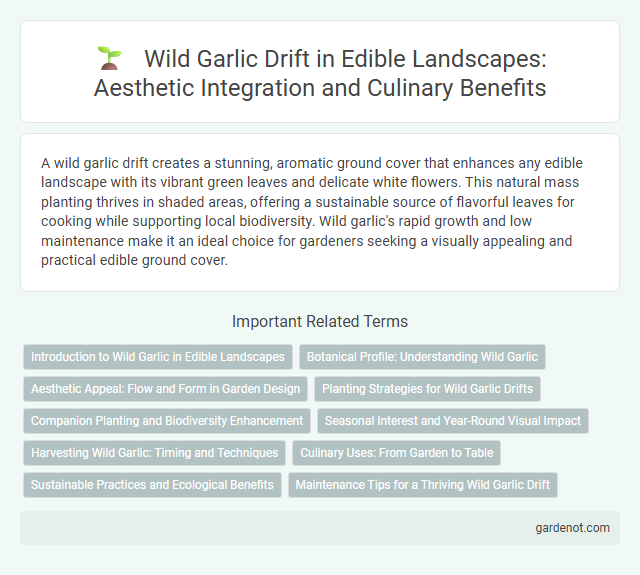A wild garlic drift creates a stunning, aromatic ground cover that enhances any edible landscape with its vibrant green leaves and delicate white flowers. This natural mass planting thrives in shaded areas, offering a sustainable source of flavorful leaves for cooking while supporting local biodiversity. Wild garlic's rapid growth and low maintenance make it an ideal choice for gardeners seeking a visually appealing and practical edible ground cover.
Introduction to Wild Garlic in Edible Landscapes
Wild garlic (Allium ursinum) is a versatile and aromatic perennial herb ideal for edible landscapes due to its rapid growth and naturalizing ability in shaded areas. Its broad, green leaves and delicate white flowers provide both culinary uses and ecological benefits, attracting pollinators and improving soil health. Incorporating wild garlic into edible landscapes offers a sustainable ground cover that enhances biodiversity and supplies fresh, flavorful ingredients for salads, pestos, and herbal remedies.
Botanical Profile: Understanding Wild Garlic
Wild garlic (Allium ursinum) thrives in damp, shaded woodlands, forming dense drifts that create a striking edible landscape feature. This perennial herb displays broad, lance-shaped leaves and star-shaped white flowers that bloom from April to June, attracting pollinators and enhancing biodiversity. Rich in sulfur compounds, wild garlic offers potent antibacterial properties and a distinctive flavor, making it a valuable botanical asset for natural foraging and culinary use.
Aesthetic Appeal: Flow and Form in Garden Design
Wild garlic drift creates a dynamic flow in garden design, enhancing aesthetic appeal through its cascading clusters of vibrant green leaves and delicate white flowers. The natural, flowing form of wild garlic thrives in shaded, woodland settings, providing seamless transitions between garden zones and softening hard landscape edges. Its seasonal bloom fosters a rhythmic visual texture that enriches the edible landscape while supporting biodiversity.
Planting Strategies for Wild Garlic Drifts
Planting wild garlic drifts involves selecting shaded or partially shaded areas with moist, well-drained soil rich in organic matter to mimic their natural woodland habitat. Cluster bulbs densely in irregular, flowing patterns to create a naturalistic effect while ensuring adequate spacing for growth and airflow. Incorporate companion plants like ferns and shade-tolerant groundcovers to enhance biodiversity and soil health in the edible landscape.
Companion Planting and Biodiversity Enhancement
Wild garlic drift serves as an exceptional companion plant in edible landscapes by naturally deterring pests and enriching soil health through its antimicrobial properties. Integrating wild garlic into garden beds fosters increased biodiversity by attracting beneficial insects and supporting pollinators essential for ecosystem balance. This strategic planting enhances crop resilience and promotes sustainable cultivation practices in diverse garden environments.
Seasonal Interest and Year-Round Visual Impact
Wild garlic drift offers vibrant seasonal interest with its striking white blossoms in spring, attracting pollinators and enhancing biodiversity. The lush green foliage maintains a hardy ground cover throughout summer and autumn, providing consistent visual appeal. Its evergreen leaves ensure year-round texture and color, making it an excellent choice for edible landscapes seeking continuous beauty and functionality.
Harvesting Wild Garlic: Timing and Techniques
Harvest wild garlic (Allium ursinum) in early spring when the leaves are tender and before the plant flowers to ensure optimal flavor and texture. Use a sharp knife or scissors to cut the leaves at the base, taking care not to disturb the bulbs for sustainable regrowth. Freshly harvested wild garlic leaves are ideal for culinary uses such as pesto, salads, and soups, offering a pungent, aromatic burst of flavor.
Culinary Uses: From Garden to Table
Wild garlic drift enhances edible landscapes with its vibrant green leaves and delicate white flowers, offering a fresh, mild garlic flavor ideal for culinary use. Gardeners can harvest leaves and flowers to add aromatic depth to salads, pesto, soups, and sauces, creating farm-to-table dishes rich in nutrients. This perennial herb grows abundantly in shaded areas, providing a sustainable and flavorful ingredient that bridges garden cultivation and gourmet cooking.
Sustainable Practices and Ecological Benefits
Wild garlic drift supports sustainable practices by naturally suppressing weeds and enriching soil health through nitrogen fixation. Its dense growth provides habitat for pollinators and beneficial insects, enhancing local biodiversity. Integrating wild garlic into edible landscapes reduces the need for chemical inputs, promoting ecological balance and long-term soil fertility.
Maintenance Tips for a Thriving Wild Garlic Drift
Regular watering during dry spells ensures wild garlic maintains lush, vibrant growth, while mulching helps retain soil moisture and suppress weeds. Pruning dead leaves in early spring promotes healthy regrowth and prevents disease buildup. Avoid overcrowding by thinning clumps every few years to improve air circulation and nutrient access for a thriving wild garlic drift.
Wild garlic drift Infographic

 gardenot.com
gardenot.com